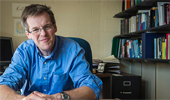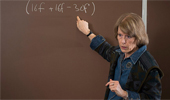Dr. Daniel Phillips, Professor of Physics & Astronomy at Ohio University, organized a five-day workshop at the national Institute for Nuclear Theory on “Few-body Universality in Atomic and Nuclear Physics: Recent Experimental and Theoretical Advances.” Phillips also chaired the May 12 morning session.
Dr. Charlotte Elster, Professor of Physics & Astronomy at Ohio University, presented on May 14 on “The Coulomb problem in momentum space without screening.” And Ohio University alum Chen Ji ’12PhD gave a presentation on “From cold atoms to halo nuclei: an EFT description of three-body physics.”
Phillips and Elster also are organizing the 21st International Conference on Few-body Problems in Physics, which will take place in Chicago in May 2015. The International Few-body Conference takes place every three years and typically attracts 300-400 physicists from all over the world.
About the INT Program on Universality in Few-Body Systems
The workshop in May at the University of Washington capped the spring 2014 INT program on “Universality in few-body systems: Theoretical challenges and new directions.” The program focused on the universality in few-body systems relevant to atomic and nuclear physics. The workshop brought together theorists and experimentalists from both atomic and nuclear physics.
“The universality of few-body systems is currently a hot topic, with many new and exciting directions. Theoretical predictions related to systems with resonant s-wave interactions can now be tested experimentally, and universal behavior has been found to extend beyond the two- and three-body problems. An equally important emerging frontier in this area is the fact that cold atomic gases can be used to engineer not only systems with resonant s-wave interactions, but also a variety of other systems, e.g. in lower dimensions or with p-wave-interactions. Gases composed of unequal-mass fermions, and where dipolar interactions are present, may also soon be realized in the strongly-interacting, low-energy regime. They, too, provide new frontiers for the investigation of universality,” says the INT program website.
“These experimental developments go hand-in-hand with rapid theoretical break-throughs. A full understanding of universal features of these more complex systems will emerge by applying a variety of theoretical techniques. While much has been achieved, many open questions remain (see below). And these questions give insight not just into atom-atom interactions, but also to systems bound by the strong nuclear force, such as halo nuclei and hadronic molecules.”
Abstract: The Coulomb Problem in Momentum Space without Screening
N. J. Upadhyay(a), V. Eremenko(b,f), L. Hlophe(b), F.M. Nunes(a), Ch. Elster(b), and G. Arbanas(c), J.E. Escher(d), I.J. Thompson(d) (a) National Superconducting Cyclotron Laboratory and Department of Physics and Astronomy, Michigan State University, East Lansing, MI 48824, USA (b) Institute of Nuclear and Particle Physics, and Department of Physics and Astronomy, Ohio University, Athens, OH 45701 (c) Reactor and Nuclear Systems Division, Oak Ridge National Laboratory, Oak Ridge, TN 37831, USA (d) Lawrence Livermore National Laboratory L-414, Livermore, CA 94551, USA (f ) D.V. Skobeltsyn Institute of Nuclear Physics, M.V. Lomonosov Moscow State University, Moscow, 119991, Russia
The TORUS Collaboration is funded by the U.S. Department of Energy.
Background: The repulsive Coulomb force poses severe challenges when solving the three-body problem for (d,p) reactions on intermediate mass and heavy nuclei. Recently, a new approach based on the Coulomb-distorted basis in momentum space was proposed.
Purpose: In this work, we demonstrate the feasibility of using the Coulomb-distorted basis in momentum space for calculating matrix elements expected in a wide range of nuclear reactions.
Method: We discuss the analytic forms of the Coulomb wave function in momentum space. We analyze the singularities in the Coulomb-distorted form factors and the required regularization techniques. Employing a separable interaction derived from a realistic nucleon-nucleus optical potential, we compute and study the Coulomb-distorted form factors for a wide range of cases, including charge, angular momentum and energy dependence. We also investigate in detail the precision of our calculations.
Results: The Coulomb-distorted form factors differ significantly from the nuclear form factors except for the very highest momenta. Typically, the structure of the form factor is shifted away from zero momentum due to the Coulomb interaction. Unlike the Yamaguchi forms which are typically used in three-body methods, our realistic form factors have a short high-momentum tail, which allows for a safe and efficient truncation of the momentum grid.
Conclusions: Our results show that the Coulomb-distorted basis can be effectively implemented.





















Comments